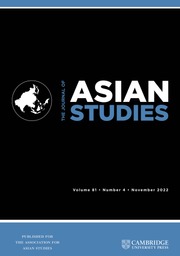Article contents
Empire in the Southwest: Early Qing Reforms to the Native Chieftain System
Published online by Cambridge University Press: 26 March 2010
Extract
By the time the Yongzheng emperor (r. 1723–35) issued the above edict in January 1728, criticism of Beijing's new confrontational approach toward the native chieftains of southwest China had already reached embarrassing proportions. With increasing frequency, civilian and military officials in Guangxi, Guizhou, Yunnan, and Sichuan referred to the state's abolition of native chieftainships as “senseless,” “a plan devoid of vision and purpose,” and “wantonly destructive of life and property.” Ortai (1680–1745), Yue Zhongqi (1686–1754), and several other officials recently assigned to the southwest by Yongzheng were labeled “reckless opportunists” intent on inciting disturbances among native chieftains and the indigenous non-Han peoples of southwest China in order to further their careers (ZPYZ, He Shiji 2a–3b; Ding Shijie 16b; Ortai 1:95a–b; Famin 21a–24b; YZSL 46:20b–21b). According to one influential official assigned to the southwest, “Your humble servant takes this opportunity to inform [the emperor] of the devastation and misery caused by [Ortai's] actions, in hope this policy towards native chieftains will be brought to an end and we can resume the strategy of peaceful assimilation initiated during previous reigns” (ZPZZ, Zu Binggui 1772.6).
Information
- Type
- Articles
- Information
- Copyright
- Copyright © The Association for Asian Studies, Inc. 1997
References
List of References
- 29
- Cited by

